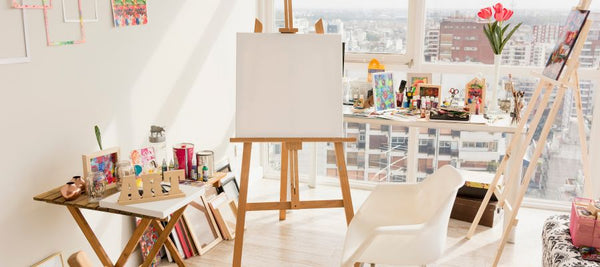This blog is supported through the affiliate links below
Studio Safety: Essential Tips for Maintaining a Safe and Healthy Oil Painting Workspace
Oil painting is one of the most enjoyable mediums to paint in and is a popular medium for several reasons. However when working in oils, it's important to understand what the risks are and what things make for a safely-equipped studio. Oil painting is often combined with the use of solvents, flammable materials, and chemicals. To minimize any risks from exposure to these materials, it is crucial to take certain precautions. By following just a few best practices for studio safety, artists can focus more on their artwork and less on worrying about their health.

Note: This blog contains affiliate links and purchasing through them supports our site at no extra cost to you.
Is oil painting safe?
Oil painting is generally considered safe for artists when proper precautions are taken. The use of oil-based paints and solvents can release volatile organic compounds (VOCs) into the air, which may cause health issues if inhaled in excessive amounts. However, artists can minimize risks by working in well-ventilated areas, wearing protective gear, and properly disposing of waste materials.
What safety measures to consider when oil painting?
Overall, studio safety is pretty basic. Having an understanding of what makes for a safe painting environment as whole will go a long ways in keeping you protected. Here are some things every artist should consider when setting up a studio for oil painting:
-
Ventilation: Ensure that there is adequate ventilation in your studio to avoid inhaling toxic fumes from solvents such as turpentine and mineral spirits. This can be achieved through the use of fans, open windows, or a ventilation system. HEPA air purifiers rated for chemicals are a great option for workspaces where proper ventilation is difficult.
-
Fire safety: Now this one may not come to mind when you think of oil painting, but the storage and disposal of flammable materials, such as rags and paper towels, is extremely important. We all know to keep flammables away from fire hazards, but we don't always think about the rags we use. ALWAYS dry out paper towels or rags that have been soaked with paint thinner prior to disposing. A bunched up rag after being used with oil paints or turpentines that hasn't been dried can oxidize over time and lead to spontaneous combustion.
-
Protective gear: On days when using a lot of thinner say for underpainting, the use gloves and maybe even protective eyewear at times is a good idea.
-
Cleaning supplies: This is an obvious one, but make sure to have close access to a sink with good soap so that you can wash off your hands often when they get exposed to paint materials.

So what about skin exposure?
Skin exposure to oil painting mediums and solvents can carry certain risks, such as irritation, sensitization, and potentially more, depending on the specific materials involved. Some of these materials may cause mild skin irritation, while others can be more hazardous. It is important to research the toxicity levels of each product, choose the best quality materials, and take appropriate precautions to minimize skin exposure whenever possible.

Anything else?
At the end of the day, most of today's professional-grade paints, mediums, and solvents are manufactured to the highest standards in studio safety. This is why it's important to use only the best quality materials if you paint everyday for long periods of time.
One good practice is to keep the lids on your cleaning jar on unless you are currently using it. Mineral spirits or turpentine from your cleaning can will be one of the biggest sources of strong odors and fumes in your workspace. I like to flip the jar's cover upside down and set it on top of the jar which doubles as a dish for my medium. When I need to clean a brush I lift it up and wash my brush, then place it back on the jar to seal off the paint thinner. Little habits like this go a long ways to reduce your exposure to the chemicals you might use in the process of painting.

Grow Your Painting Skills and Resources
Instant access to 1000s of royalty-free reference photos of landscapes and wildlife as well as step by step oil painting videos. Checkout My Memberships for more info.

I'm Chuck Black, landscape and wildlife artist based in Southwest Montana.





